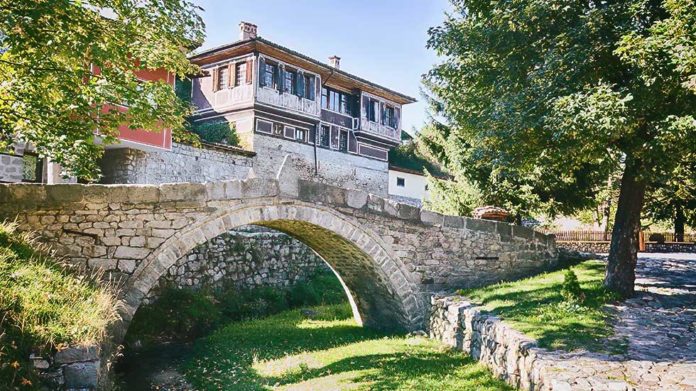Nestled in the heart of Bulgaria, just under two hours away from the capital city of Sofia, lies a hidden gem waiting to be explored. Koprivshtitsa, a picturesque village with a fascinating past, is a treasure trove of cultural and historical landmarks that transport you back to the days of the Bulgarian Revival period. With its cobbled streets, stunning period houses, and captivating history, Koprivshtitsa offers a unique experience for those who venture this far.
Getting to Koprivshtitsa is a breeze, with the road taking you directly to the village in just under two hours by car from Sofia. Alternatively, guided tours allow you to explore Koprivshtitsa alongside other destinations, such as Plovdiv.
Stepping into Koprivshtitsa is like entering a living museum, where the architecture and atmosphere evoke the spirit of the 18th and 19th centuries. The village is renowned for its beautiful stone and wooden houses adorned with large balconies, stone fountains, arched bridges, and high walls. Six museum houses showcase the village’s rich history, and the entire area is declared a national monument, situated in a breathtaking valley surrounded by forests, rivers, and mountains.
Founded at the end of the Second Bulgarian Empire, Koprivshtitsa is steeped in history and legends. The city has been burnt down and rebuilt three times, a testament to its resilience and determination. The birthplace of many notable figures of the Bulgarian Risorgimento is where the first bullet was fired against the Ottomans in 1876, sparking the April insurrection that ultimately led to Bulgaria’s liberation.
During your visit to Koprivshtitsa, explore the remarkable museum houses, each offering a unique glimpse into the past. The Kableshkov House Museum, the birthplace of the revolutionary Todor Kableskov, immerses you in the daily life of the time while also showcasing the owner’s life and revolutionary activities. The Oslekov House Museum, home to an ethnographic museum dedicated to 19th-century Bulgaria, tells the story of a cloth merchant who traveled the world and supported the national liberation struggle.
Other must-see museum houses include the Ljutov House Museum, Dimco Debeljanov House-Museum, Georgi Benkovski House Museum, and Ljuben Karavelov House Museum. To experience all that Koprivshtitsa offers, you can purchase a combined ticket from the Kupchinitsa souvenir shops or the Kableshkov House, granting access to all six museum houses.
Koprivshtitsa, with its vibrant history, stunning architecture, and serene natural surroundings, offers an unforgettable experience for travelers seeking a glimpse of Bulgaria’s rich cultural heritage. This enchanting village is the perfect destination for anyone looking to immerse themselves in the past while discovering Bulgaria’s hidden gems. Don’t miss the chance to explore this remarkable village and create lasting memories of your journey through time.
Legends About Koprivshtitsa
A captivating tale recounts how the early settlers of Koprivshtitsa sought marriage partners from neighboring villages to maintain diversity within their community. According to this legend, a peasant woman from Turnovo ventured to the Rila mountain in search of a better life. Along the way, she discovered the fertile lands of Koprivshtitsa and decided to settle there, contributing to the village’s growth and prosperity.
The story continues with the peasant woman traveling to Edirne to plead with the sultan for privileges for Koprivshtitsa. Impressed by her ambition and courage, the sultan granted her request, bestowing the village with the name Avrat Alan, or “woman’s meadow.” This decree endowed Koprivshtitsa’s citizens with unique privileges, such as the freedom to carry weapons, trade, and retain a portion of their taxes. However, these privileges also made Koprivshtitsa a target for raids and plundering.
One of the most curious legends, though not directly related to the founding of Koprivshtitsa, is that of the Sooty Stones. Now considered a historical and cultural landmark, these stones represent the moraine where villagers bid farewell to men leaving for temporary work abroad. The name “Sooty Stones” derives from the heart-wrenching cries accompanying each departure.
The Name Koprivshtitsa
Koprivshtitsa is believed to have originated from the Thracian word for “nettle” or “hive.” Another interpretation associates the name with the altered terms “koprišitsa” or “kyupre,” which stem from the Greek word “torishte” – koprià. Cuprets, interestingly, are connected to a local craft – felting. Learn more about the wool felting tradition in Bulgaria.
Koprivshtitsa’s cobbled streets, beautifully preserved revival houses, and captivating legends create an atmosphere of wonder and inspiration. As you wander through this enchanting village, allow the stories of its past to enhance your experience, deepening your connection to Koprivshtitsa’s rich cultural heritage.



